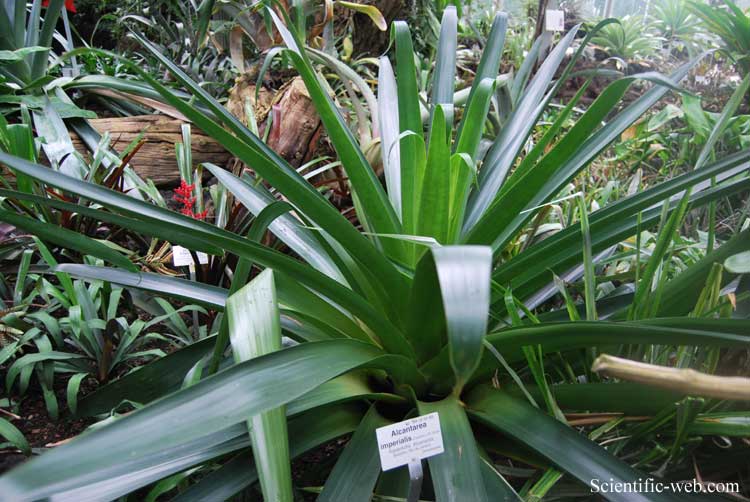
Alcantarea imperialis, Photo: Michael Lahanas
Classification System: APG IV
Superregnum: Eukaryota
Regnum: Plantae
Cladus: Angiosperms
Cladus: Monocots
Cladus: Commelinids
Ordo: Poales
Familia: Bromeliaceae
Subfamilia: Tillandsioideae
Tribus: Vrieseeae
Genus: Alcantarea
Species: Alcantarea imperialis
Name
Alcantarea imperialis (Carrière) Harms in H.G.A.Engler, Nat. Pflanzenfam. ed. 2, 15a: 126 (1930).
Synonyms
Basionym
Vriesea imperialis Carrière, Rev. Hort. (Paris) 60: 56 (1888).
Heterotypic
Vriesea gigantea Lem., Ill. Hort. 14: t. 516 (1867), sensu auct.
Vriesea imperialis É.Morren ex Mez in C.F.P.von Martius & auct. suc. (eds.), Fl. Bras. 3(3): 568 (1894), nom. illeg.
Distribution
Native distribution areas:
Continental: Southern America
Regional: Brazil
Brazil (Minas Gerais, Rio de Janeiro)
References: Brummitt, R.K. 2001. TDWG – World Geographical Scheme for Recording Plant Distributions, 2nd Edition
References
Harms, H. in H.G.A.Engler, 1930. Nat. Pflanzenfam. ed. 2, 15a: 126.
Links
Govaerts, R. et al. 2019. Alcantarea imperialis in World Checklist of Selected Plant Families. The Board of Trustees of the Royal Botanic Gardens, Kew. Published on the internet. Accessed: 2019 Jun 29. Reference page.
International Plant Names Index. 2019. Alcantarea imperialis. Published online. Accessed: Jun 29 2019.
The Plant List 2013. Alcantarea imperialis in The Plant List Version 1.1. Published on the internet. Accessed: 2019 Jun 29.
Tropicos.org 2019. Alcantarea imperialis. Missouri Botanical Garden. Published on the internet. Accessed: 2019 Jun 29.
Vernacular names
Alcantarea imperialis is a species of bromeliad in the genus Alcantarea.[1] This species is endemic to Brazil.[1]
It was first described in 1888 as Vriesea imperialis by Élie-Abel Carrière, who dedicated it to the emperor of Brazil with the species epithet, imperialis.[2] It was assigned to the genus, Alcantarea, by Hermann Harms in 1930.[3]
Description
This large terrestrial bromeliad was once classified as Vriesea imperialis but is now recognized as part of the genus Alcantarea. It can be found growing on rocky slopes in the Serra dos Órgãos in Rio de Janeiro. It can tolerate dry conditions and full sunlight. Considered one of the giants of the genus, "its leathery leaves measuring 6 inches in width and 5 feet in length."[4] It will take years before producing an imposing red inflorescence that reaches 8 feet in height.
Cultivars
Alcantarea 'Ajax'
Alcantarea 'Black Cinder'
Alcantarea 'Gladys'
Alcantarea 'Helenice'
Alcantarea 'Purple Skotak'
Alcantarea 'Silver Plum'
Alcantarea 'Tarawera'
Alcantarea 'Totara Orange'
References
"Alcantarea imperialis (Carrière) Harms | Plants of the World Online | Kew Science". Plants of the World Online. Retrieved 2021-12-08.
Carrière, E.-A. (1888). "Vriesia imperialis". Revue horticole. Paris. 60: 58.
Harms, H.A.T. (1930) Die natürlichen Pflanzenfamilien, ed. 2 [Engler & Prantl] 15a: 126
Padilla, Victoria (1973). Bromeliads. New York: Crown Publishers. pp. 104. ISBN 0517562413.
Martinelli, Gustavo; Vieira, Cláudia Magalhães; Gonzalez, Marcos; Leitman, Paula; Piratininga, Andréa; Costa, Andrea Ferreira da; Forzza, Rafaela Campostrini (January 2008). "Bromeliaceae da Mata Atlântica Brasileira: lista de espécies, distribuição e conservação" [Bromeliaceae of the brazilian Atlantic Forest: checklist, distribution and conservation]. Rodriguésia (in Portuguese). 59 (1): 209–258. doi:10.1590/2175-7860200859114. JSTOR 23499386.
BSI Cultivar Registry Retrieved 11 October 2009
Retrieved from "http://en.wikipedia.org/"
All text is available under the terms of the GNU Free Documentation License

